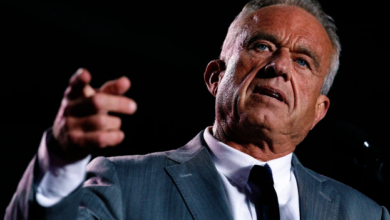Ohio Seeks To Become Latest State To Ban Noncitizen Voting


COLUMBUS, Ohio (AP) — Republicans in Ohio are promoting a measure on the Nov. 8 ballot that would prohibit noncitizens from voting in local elections, fighting back at what they see as a push for such access in liberal enclaves such as San Francisco and New York City.
It would make Ohio the seventh state to take such a step if it passes and could motivate turnout among GOP voters in this year’s high-stakes midterm elections. The state also has a close race for a seat that will help determine the balance of power in the U.S. Senate.
Republican Secretary of State Frank LaRose, the state’s elections chief, is championing State Issue 2, a proposal advanced by Ohio’s GOP-led state Legislature. It would make a tiny but pivotal wording change to the Ohio Constitution, from guaranteeing voting rights for “every citizen” of the U.S. who meets certain criteria to “only citizens” of the U.S. who do.
LaRose, who is up for reelection, said most people had assumed that a prohibition in place since 1996 on noncitizen voting in federal and state elections also applied to local elections, though the law was silent on the matter. That was, until a “bad idea” crept in from the East and West coasts, he said.
“It’s a bad idea to callously give away the right to vote to people that haven’t earned it,” LaRose said at an October news conference touting the issue. “I think that citizenship has value, citizenship has status. So many of our ancestors worked so hard to earn that citizenship.”
As of 2020, six states — Alabama, Arizona, Colorado, Florida, Minnesota and North Dakota — adopted the “only citizens” alternative in their state constitutions, according to the group Americans for Citizen Voting.
Legal immigrants fighting for the right to vote in local elections invoke a similarly patriotic rallying cry, this one from the American Revolution. They say they pay taxes, yet can’t vote on offices such as mayor or city council or on levies for their kids’ schools.
“We are all taxpayers,” said Melissa John, a New York City school teacher and green card holder who fought for the city’s noncitizen voting rights law, which passed in January but has since been put on hold by a judge.
“So if my monies are going to be going into a system to fund and make changes in my immediate community, or wherever I teach or I work or I socialize, then I — and other individuals like myself — should be able to put our voice behind individuals that align with your philosophy,” she said.
In Ohio, only one small town in modern times — liberal, 3,700-resident Yellow Springs — has approved a charter amendment allowing noncitizen voting on local candidates and issues. The amendment passed by referendum in 2019, but it was stopped by LaRose, who asserted that the program violated both the state and federal constitutions.
Village leaders disagreed, said City Council President Brian Housh, but they didn’t have the resources to mount a legal challenge. They would have argued that expanding voting to noncitizens falls within Yellow Springs’ rights to home rule and local control, he said.
LaRose said at the news conference that, besides defying one of the key privileges of citizenship, allowing noncitizens to vote would create “a huge administrative lift and burden” for local boards of elections. That’s something Housh also disagrees with. He said the Greene County Board of Elections told the village it was “quite confident” it could handle offering and counting ballots for the estimated 30 noncitizens who could have been added to the rolls.
Housh views the anti-immigrant rhetoric around the ballot issue as a scare tactic to drive GOP voters to the polls and generate campaign contributions.
“We’ve been accused by Secretary LaRose of disrupting the election process and being un-American,” Housh said. “I get it. Most communities in Ohio would probably not enfranchise non-U.S. citizen residents to vote. But that fits our community. Our citizens value that diversity and think people who contribute to the community should be represented.”
Yellow Springs took its cue from Maryland, which has 11 of the 15 municipalities in the U.S. that have approved noncitizen voting. New York, San Francisco and two towns in Vermont round out the list.
Barney Rush, the mayor of Chevy Chase, Maryland, said his suburban Washington, D.C., community has a number of residents who are foreign-born and working at embassies or for international organizations — and they wanted a say in local life.
“These are longstanding town residents, they have a very keen interest in town affairs, many of them owned property and so they had a vested interest in how the town conducted itself,” he said. “For us, it was really just a matter of recognizing people living in the town.”
He estimated roughly 20 noncitizens were added to the rolls in a community of about 1,000 homes, and said the program has been without incident since it was passed in 2018.
What concerns Republicans is that a trend that began in a few small towns has begun to catch on in bigger cities.
San Francisco allows noncitizen parents and guardians of schoolchildren to vote in school board races. About 13,600 students come from families whose second language is English — one possible indicator of how many thousands of people might be eligible. The city doesn’t know for sure, said elections director John Arntz, but so far only 63 noncitizens have registered.
In New York, more than 800,000 noncitizens and “Dreamers” — those brought to the U.S. as children — would be empowered to vote under its new law. A similar proposal is on the November ballot in Oakland, a city of about 420,000 across the bay from San Francisco. The city council in the District of Columbia, a city of more than 700,000, voted just this month to allow noncitizen voting.
State Rep. Bill Seitz, one of the Republican co-sponsors of the Ohio legislation that advanced the noncitizen prohibition onto the ballot, said it is particularly important for Ohio to act because its cities have the ability to tax people who work, but do not live, there.
“So if these cities pick up the liberal progressive mantra of allowing noncitizens to vote, they will be able to vote not only in their local elections but on increasing the taxes payable by the nonresident workers who commute into the city to work,” he said. “That’s why all of us — township residents, folks in the unincorporated area, folks in the rural area — better wake up.”
Among U.S. citizens who back the Ohio amendment is Luis Gil, a Republican running for county commissioner in central Ohio. Gil moved to the U.S. from Venezuela when he was 18 and said he never believed in shortcuts to the privileges of citizenship.
“Most immigrants, we don’t think this way,” he said at LaRose’s news conference. “We know that we have to earn this. We have to abide by the same rules as everyone, that’s it.”
Follow AP’s coverage of the elections at: https://apnews.com/hub/2022-midterm-elections
Check out https://apnews.com/hub/explaining-the-elections to learn more about the issues and factors at play in the 2022 midterm elections.
[ad_2]
Source link





